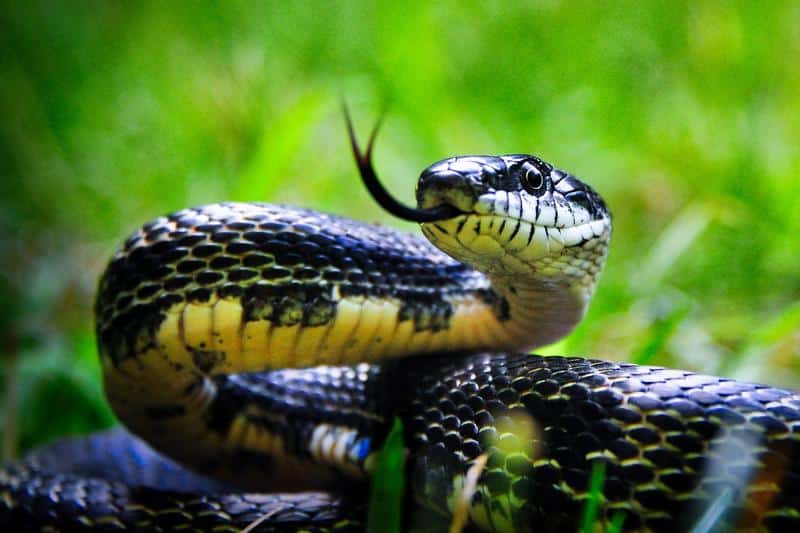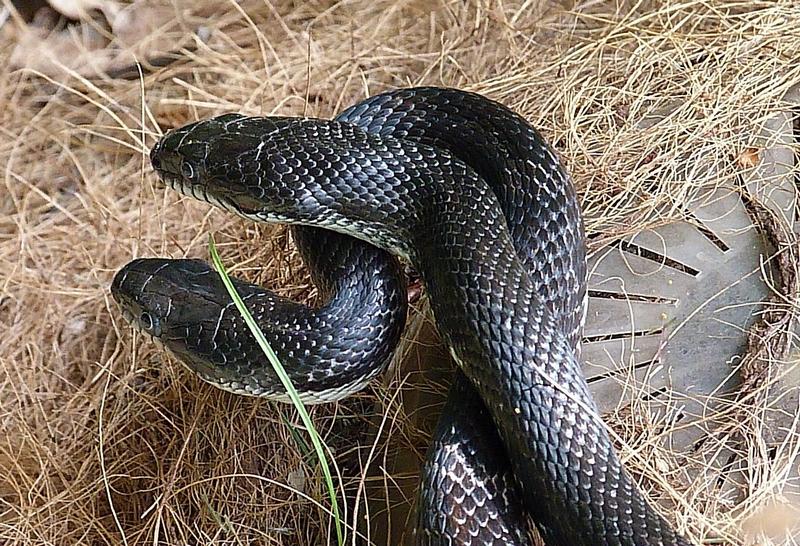Black Snake Bites Dog: Are Black Snakes Poisonous to Dogs?
Are black snakes poisonous to dogs? If a black snake bites your dog, what do you do and how worried should you be? In this article, we’ll answer all of these questions, then we’ll teach you the two commands you’ll need to be sure your dog is always safe around black snakes from now on.
Next, we’ll cover everything you need to know so you can make a proper identification and then react appropriately. We’ll tell you what a black snake looks like, where black snakes are found, and how to tell the difference between black rat snakes vs black racers. Finally, we’ll instruct you on how to get rid of black snakes. Keep reading!
Black Snake Bites Dog

If a black snake bites your dog, don’t panic. Black snakes, also known as the black rat snake, are non-venomous and their bite is not poisonous to dogs. However, immediate medical attention should still be sought to prevent any secondary infection and to ensure your pet’s well-being.
Dog Bitten by Black Snake
When a black snake feels threatened, it may bite in self-defense. If your dog has been bitten, the first step is to keep your pet calm and try to inspect the area of the bite. There may be small puncture wounds that can become infected if not treated promptly. Although black rat snakes are not venomous, a bite can still cause discomfort or an allergic reaction in some dogs.
Black Snake Bite on Dog Symptoms
Black snake bites may cause localized swelling, redness, and pain, and your dog might show signs of distress or discomfort. Some dogs may react more dramatically to the bite, displaying signs such as whimpering, excessive licking of the bitten area, and behavioral changes.
In rare cases, an allergic reaction may occur, leading to symptoms like difficulty breathing, drooling, vomiting, or even collapse. If your dog displays any of these symptoms, seek veterinary help immediately.
Train the “Stay” Command
One way to prevent snake bites is to train your dog to understand and respond to commands, such as “stay”. Here’s a simple process you can follow:
- Start by saying “stay” in a firm and calm voice when your dog is in a sitting or down position.
- If your dog stays put, reward them with a treat or praise.
- Gradually increase the distance between you and your dog, and the duration of the “stay”.
- Remember to be consistent and patient, as this training may take time.
Train the “Leave It” Command
The “leave it” command is another essential command that can help keep your dog safe. Here’s a recommended method to teach this command:
- Start with a less desirable item in one hand and a high-value treat in the other.
- Say “leave it”, and wait for your dog to ignore the less desirable item and look at you.
- When they do, reward them with the high-value treat.
- Practice this command regularly, gradually moving to more tempting items, until your dog reliably responds to the command even in potentially dangerous situations, like encountering a snake.
These steps will get your dog to stay away from black snakes, but it’s important to remember that the underlying behavioral issues (prey drive, aggression, dominance) that were causing all of this to begin with will still be present. And until you address those, any positive changes you see are only going to be temporary.
“Well, how do I make these changes last?”
By getting your dog to truly choose to follow your direction, that’s how. I tried many times to write out how you can do that before deciding it made more sense to just link you to the free video series that explains it better than I’d ever be able to.
The series is by a man named Dan who is one of the world’s leading dog obedience trainers. In it, he teaches you how to put an end to things like when your dog is chasing black rat snakes and all other misbehavior using his fast and easy-to-follow methods.
In the first video, Dan will reveal to you why the two most common methods of dog training only doom you to failure. You can watch the video now by clicking here. Follow the proven system he’ll show you in his series and you’ll never have to spend another second worrying about your dog chasing black snakes ever again!
Are Black Snakes Poisonous to Dogs?

Black snakes are not poisonous to dogs. Black snakes (more specifically known as the black rat snake) are non-venomous. However, a bite from any snake should be treated with caution as it can lead to secondary infections and allergic reactions in some dogs.
Are Black Snakes Dangerous to Dogs?
While black rat snakes are non-venomous and pose no direct threat via their bite, any snake encounter can still be dangerous for your dog. A frightened snake may bite in defense, and while the bite itself may not be venomous, it can still cause discomfort, stress, and potential allergic reactions in your dog.
Plus, puncture wounds from any bite can lead to secondary infections if not treated promptly.
Can Black Snakes Kill Dogs?
Black rat snakes are not venomous and their bite alone won’t kill a dog. However, any kind of snake bite should not be taken lightly. An untreated bite could potentially lead to an infection, which can be harmful if left untreated. There’s also a risk of an allergic reaction that could lead to serious health problems if immediate veterinary care is not sought.
Preventing Snake Encounters
The best way to keep your dog safe from black snakes, or any snake, is to prevent encounters altogether. This can be achieved by keeping your yard clean and free of clutter where snakes might hide, keeping your dog on a leash during walks, and training them to understand commands like “leave it” and “stay”. Learn both in the first section.
You should get this issue taken care of right away as it will also keep your dog safe during other potential snake meetings. You then won’t have to worry about things like copperheads biting your dog, corn snakes biting your dog, garter snakes biting your dog, king snakes biting your dog, or milk snakes biting your dog.
What To Do If Your Dog Encounters a Black Snake
If your dog encounters a black rat snake, it’s important to stay calm and try to remove your dog from the situation without startling the snake. If a bite occurs, get your pet to a vet immediately, even if the bite is from a non-venomous snake. The vet can clean the wound and administer any necessary treatment, such as antibiotics, to prevent infection.
What Does a Black Snake Look Like?
Black snakes, or more specifically, black rat snakes, are among the most easily recognizable serpents due to their distinct dark coloration and significant length. They are usually entirely black, and their skin has a glossy, almost polished appearance.
Their belly side can range from white to a light gray, sometimes showing a checkerboard pattern. Adult black rat snakes can reach lengths up to 6 feet, but some have been known to grow as long as 8 feet. Their bodies are relatively slender and their heads are wider than their necks, with round pupils.
What Black Snakes Look Like
Black rat snakes are characterized by their solid black, glossy scales, which provide them excellent camouflage in dark, wooded areas. Their undersides are usually lighter, often exhibiting a pattern that ranges from white to gray.
These snakes have keeled scales, meaning each scale has a raised ridge down the center, giving them a slightly rough texture. Their eyes are also an identifying feature – black rat snakes have round pupils, unlike some venomous species which have slit-like pupils.
Where Black Snakes Are Found
Black rat snakes are found throughout the eastern and central United States. They prefer forested areas, but are also known to inhabit fields, meadows, and farmland. They are excellent climbers and are often found in trees, which is also where they hunt their primary food source, rodents.
These snakes are also known to inhabit old buildings and barns, where they can help control rodent populations.
Black Rat Snakes vs Black Racers
Black rat snakes and black racers are often mistaken for one another due to their similar coloration. However, there are several distinguishing features. Black racers tend to have a more uniform, jet-black color throughout, including their belly, while black rat snakes often have a patterned or lighter-colored underside.
Black racers are usually slightly smaller and have a more slender body compared to the black rat snake. Behaviorally, black racers are known to be more active during the day and are faster and more likely to flee when encountered, while black rat snakes are somewhat more docile and may freeze or try to slowly slither away when confronted.
Learn the commands you’ll need to keep your dog safe around black snakes (or any other critters) by going back to the first section now.
How to Get Rid of Black Snakes
You can naturally get rid of black snakes by reducing their food sources, using snake repellents, maintaining your yard, and seeking professional help if necessary. These methods are safe, eco-friendly, and pose no harm to dogs.
- Reduce Food Sources: Black snakes, like all predators, are attracted to areas with abundant food sources. If your property is overrun with rodents, chances are high that it will attract snakes. Therefore, implementing pest control methods to eliminate rodents can significantly decrease the presence of black snakes.
- Use Snake Repellents: Natural snake repellents, like those that contain clove oil and sulfur, can be used to deter black snakes. Spread the repellent around your home, focusing on areas where you’ve spotted snakes. However, be cautious of any repellent’s ingredients, as some may not be safe for pets. Always opt for pet-friendly options.
- Maintain Your Yard: Keeping your yard clean and clutter-free can help deter black snakes. Regularly mow the lawn, remove dead leaves and branches, and clear away any piles of wood or rocks that might provide shelter for snakes. The less attractive your yard is to a snake, the less likely it is to stay.
- Professional Assistance: If you’re dealing with a persistent black snake problem, consider reaching out to a professional pest control service. They have the knowledge and equipment to handle snake infestations safely and effectively, without posing a risk to your dogs or other pets.
In conclusion, the safest ways to get rid of black snakes include reducing their food sources, using natural snake repellents, maintaining a clean yard, and seeking professional help if required. These methods ensure a snake-free home without posing any danger to your pets. Learn the commands that will help in the first section.
I’m sure you’re ready to not worry about anymore issues between black snakes and dogs, so I’ll let you get started now. Good luck with all of this, and thanks for reading our article “Black Snake Bites Dog: Are Black Snakes Poisonous to Dogs?”





